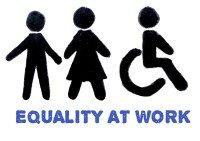Disability discrimination occurs when an employee is treated less favourably than other employees because of a disability. Employers must take steps to prevent discrimination and harassment in the workplace; they also have a duty to make reasonable adjustments to prevent employees from suffering a disadvantage. Our disability discrimination solicitors are able to assist with any issues that you might be having in the workplace.
Defining Disability
Section 6 of the Equality Act 2010 defines a person having a disability as:
”a person who has a physical or mental impairment which has a substantial and long-term adverse effect on their ability to carry out normal day-to-day activities”.
In other words, there must be a physical or mental reason why a person finds it significantly more difficult to carry out normal everyday tasks and that reason must be a long-term problem.
‘Substantial‘ in this instance means more than trivial. Put differently, the physical or mental impairment must have an adverse effect on day to day activities. For example, it might take longer or be much more difficult to carry out normal activities at work.
‘Long-term‘ in the workplace generally means more than 12 months or likely to last for more than 12 months. So a broken arm which will heal within 6 weeks is not a disability but arthritis in an elbow joint would be a disability.
For Example
Mr Smith is dyslexic, it takes him significantly longer to read and prepare written reports at work. His condition is a disability because it has a substantial and long-term adverse effect on his ability to carry out normal day-to-day activities.
What if an impairment is worse some days than others?
Some conditions recur or fluctuate in their severity. Rheumatoid arthritis is a good example of this, it can flare up and cause significant incapacity and then subside and be almost symptom free. Any condition which has ceased to have a substantial effect but is likely to recur is still considered a disability even during the times when it is not causing a problem.
Deemed Disabilities
Some impairments are automatically considered disabilities even before they have a significant impact on an employees ability to carry out everyday tasks. People who are diagnosed with cancer, HIV and MS fall into this category. They are considered disabled from the point of diagnosis not the point at which their symptoms begin to cause significant adverse effect. Blind and partially sighted employees are also deemed to have disabilities.
Some conditions are not considered disabilities and are specifically excluded hay fever is a notable exception as are alcoholism and drug addiction. A full list of excluded conditions appears in the ‘Guidance on Matters to take into Account in Determining Questions Relating to the Definition of Disability‘.
Disability Discrimination after Recovery
(Equality Act 2010 section 6(4))
Employees who have recovered from debilitating illnesses and therefore ceased to have a disability are still protected from any discrimination arising from their past disability.
For example, Mrs J works in sales and has recovered from breast cancer. She took a significant amount of sick leave in the previous year and her sales figures as a result were much lower than her colleagues. Two potentially discriminatory things happen on her return to work:
- Her colleague is promoted on the basis that he has achieved better sales.
- Mrs J is also told that she may not take annual leave this year because she had so much time off sick last year.
Mrs J no longer has cancer, however she is still protected from the discrimination that she is suffering as a result of her past disability.
Types of Disability discrimination
Direct discrimination
Is treating an employee less well because they have a disability. For example, not giving a job to a candidate who uses a wheelchair even though they are the most suitable applicant.
Indirect discrimination
Is the situation which occurs when an employer has a ‘provision, criterion or practice’ which, although it is applied equally to all employees, disproportionately affects disabled employees.
For example, if all applicants for a job are asked to take a written exam despite written work not being part of the role this might unnecessarily disadvantage a candidate with learning difficulties or dyslexia.
Harassment
Occurs when unwanted conduct which violates a person’s dignity and/or creates an intimidating, hostile, degrading or offensive environment in which to work. There is no need for a person to have a disability for them to complain of disability related harassment.
For example, a man with learning difficulties is bullied by his colleagues. He is ridiculed and made to do unnecessary tasks for their collective amusement. His employer should have taken steps to prevent this type of discrimination from happening.
Victimisation
Is the term used to describe a person being treated unfavourably because they have made a complaint about discrimination.
Employer’s Duty to make Reasonable Adjustments
Section 20 of the Equality Act 2010 requires employers to make reasonable adjustments if an employee is at a disadvantage because of their disability.

